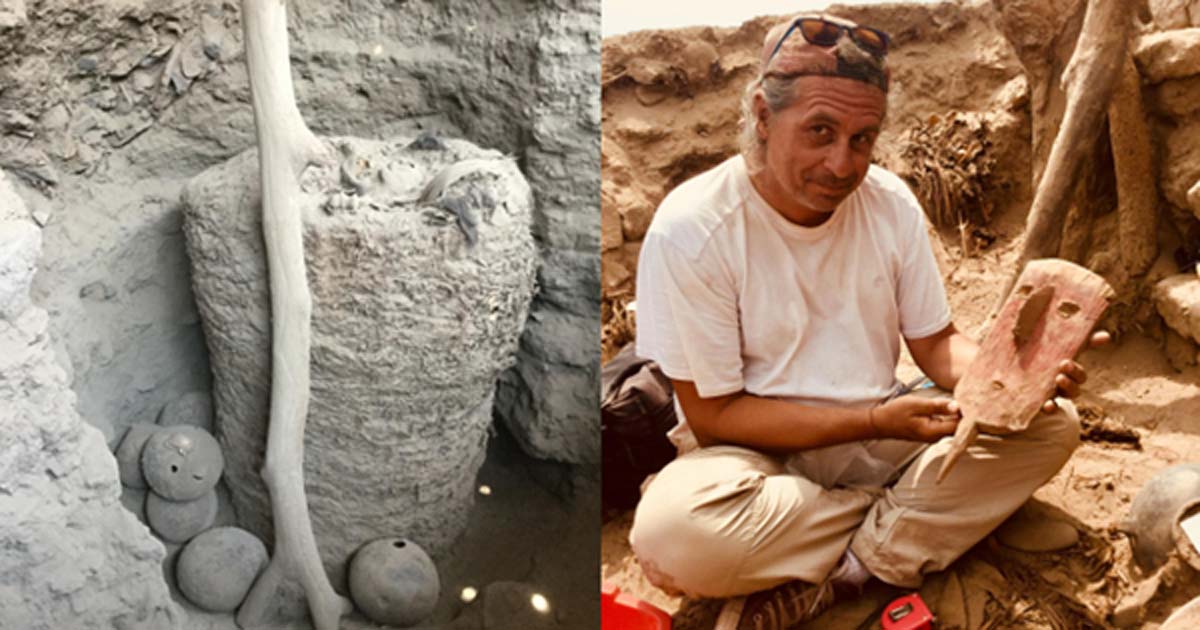Exceptional Mummy Unearthed Giving Insights into the Incan Rule
A team of archaeologists from the Université libre de Bruxelles's has uncovered a 1000-year-old mummy at an excavation in Pachacamac, on Peru’s Pacific coast. After a dig of nine weeks the team at the important religious site that pre-dates the Inca period made the astonishing find. The discovery of the mummy, by the archaeologists working on the 'Ychsma' project, named after the region's native people, is very rare and greatly excited the team. The find is leading to new questions about the Incas and their attitude to the belief systems of the subject people in their vast Empire.

Mamacona, House of the Sun Virgins, from the Pachacamac ruins in Peru. (CC BY-SA 3.0)
Pachacamac’s Site
The Incas established a large Empire centered in the Andes prior to the arrival of the Spanish Conquistadors. Religion and ritual played a very important role in the life of the Pre-Columbian civilization. The Pachacamac site, where the mummy was brought to light by Peter Eeckhaut and his team, was a significant place of pilgrimage and was in use way before the Inca conquest of the area. It was built around an idol of a god, who was stationed on a platform. Pachacamac is on the Inca road system, a listed UNESCO World Heritage Site and was in use for many centuries.
- The little-known Pachacamac mummies of Peru
- Ring of Babies: The disturbing scene found in 1,000-year-old tomb in Peru
- Four Pre-Inca Burials Discovered at 1500-year-old Site in Peru

Pyramid with a ramp at Pachacamac site. (CC BY 3.0)
The mummy was found during the planned dig of three monumental structures in the sanctuary. The experts believe these structures, were originally related to a local ancestor cult. According to the press release from Université libre de Bruxelles, when the Incas conquered the area in the late 1400s they transformed the sanctuary ‘into a water and healing temple’.

Spondylus shells from the Ecuadorean coast were found in the Incan monumental area. (Image: © P. Eeckhout, ULB)
Evidence for this was provided by the many shells that were left by worshippers, which were associated with the rains brought by El Niño, symbolizing fertility and wealth. The Incas also added monuments for ritual purposes and according to a Spanish chronicler 'chapels' for foreign pilgrims were also located at the site.

The remains of a dog were found, possibly a sacrifice. (© P. Eeckhout, ULB)
The Pachacamac Mummy
Mummification was practiced by very many Pre-Columbian societies in the Andes. The mummy was found in an undisturbed funerary chamber, which was probably built around 1000-1200 AD and pre-dates the Inca Empire. Before the Inca conquered the area, the site contained large funerary chambers, where many mummies were deposited. The majority of these sanctuaries were looted during the conquest of the area by the Spanish. According to Heritage Daily, ‘miraculously, one of the chambers was found intact during the latest round of excavations.’

This is the most recent Pachacamac mummy, 2018. (Image: © ULB P. Eeckhout)
The mummy is in remarkable condition and it is very well-preserved. The deceased person was still wrapped in a heavy bundle that served as its coffin. The material from the bundle is being carbon-dated. These days, there is no need to unwrap the bundle and it can be examined by using medical imaging techniques including 3-D reconstructions and this will ensure that the mummy is kept intact. The imaging will allow them to discover something about the identity of the individual and if there are any artifacts wrapped with the deceased.
This is far from the first mummy to be found at Pachacamac. Graves have been being uncovered there since the 1890s. Most alarmingly, in 2012, Belgian archaeologists working at Pachacamac uncovered a 1000-year-old tomb in front of the Pachacamac Temple. This tomb contained more than 80 skeletons and mummies, many of which were infants.
- Fire Mummies - The Smoked Human Remains of the Kabayan Caves
- Why Were Chinese Workers Buried at a Pre-Inca Huaca in Peru?
- Scientists Set to Unravel Secrets of Oldest Peruvian Mummies Ever Found

Peter Eeckhout holds a burial face mask that was found at the site. (Image: ©ULB P. Eeckhout)
A Significant Find
The find of the mummy at the site allows us to understand the role of religion in the Incan Empire. The Incas did make many changes to the site. However, they integrated the site into their own religious and political system. This was important for creating a common sense of identity among its subject peoples. The fact that the Incas did not remove the mummy indicates a level of respect for local beliefs and that they even combined them into their own belief system. The nature of the pre-Incan culture that built the original sanctuary is little known and it is hoped that the mummy can provide new insights into this ancient society.
Top image: A Pachacamac mummy/ Peter Eeckhout with burial face mask. Source: ULB P. Eeckhout
By Ed Whelan

















